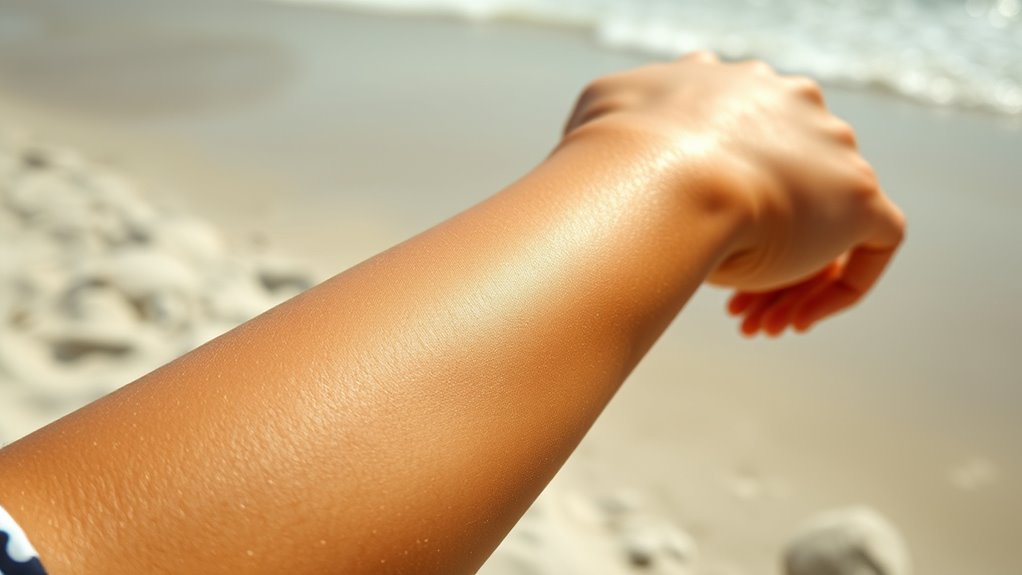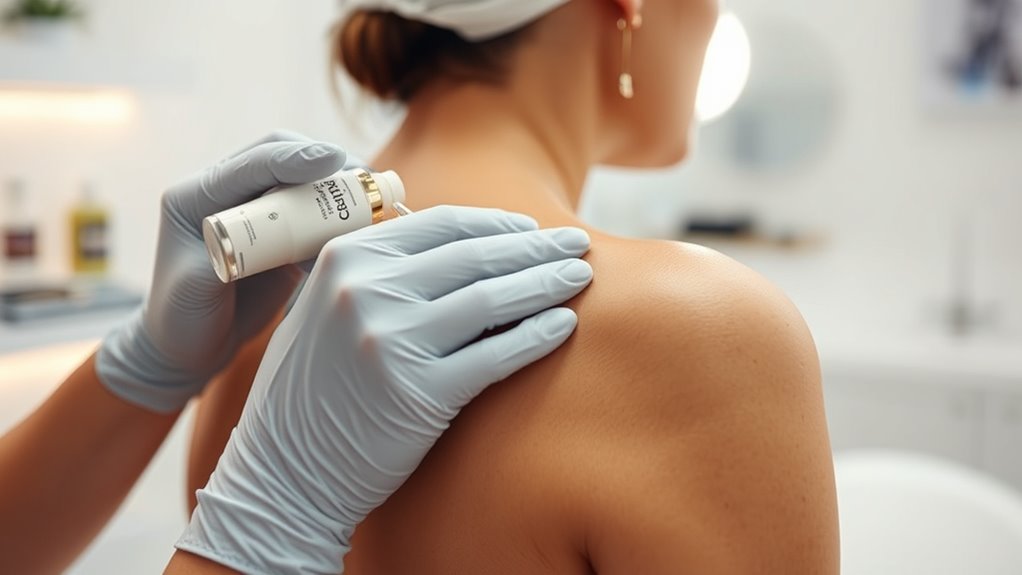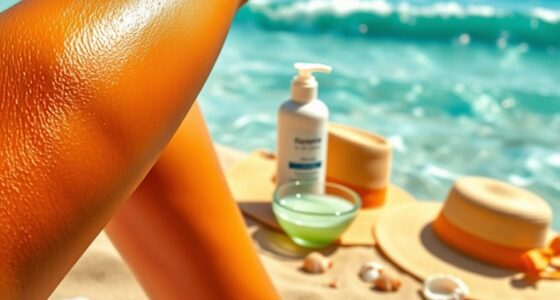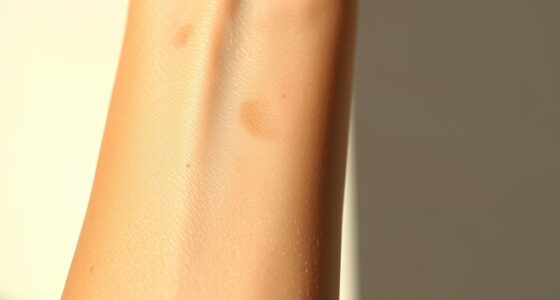To minimize and treat tan lines, start by protecting your skin: use broad-spectrum sunscreen generously and regularly, wear protective clothing, and schedule outdoor activities during safer hours. For existing tan lines, try natural remedies like exfoliation, masks, or skincare products with vitamin C and niacinamide. For severe cases, professional treatments like laser therapy or chemical peels can help even out your skin. Keep exploring for more tips on achieving a uniform, healthy glow.
Key Takeaways
- Regularly exfoliate with physical scrubs or chemical exfoliants to remove dead skin and promote even skin tone.
- Use natural remedies like lemon-honey masks and aloe vera to lighten and fade tan lines gradually.
- Maintain skin hydration and apply broad-spectrum sunscreen daily to prevent further uneven tanning.
- Consider professional treatments such as laser therapy or chemical peels for faster, more effective tan line removal.
- Wear protective clothing, avoid peak sun hours, and plan outdoor activities strategically to prevent new or worsening tan lines.
Understanding How Tan Lines Form

Tan lines form when your skin responds unevenly to UV exposure, creating a stark contrast between sun-exposed and covered areas. When UV rays penetrate your epidermis, they stimulate melanocytes to produce melanin, darkening exposed skin. This process involves UV-triggered melanotropin (MSH) binding to melanocortin 1 receptors on melanocytes, activating cAMP/PKA signaling, and phosphorylating CREB proteins. This boosts MITF gene expression, leading to increased tyrosinase enzyme production, which synthesizes melanin. Melanin then transfers to keratinocytes, coloring the skin. Areas shielded by clothing or accessories receive less UV, resulting in less melanin and paler skin. The boundary between tanned and untanned skin creates visible tan lines, with their sharpness depending on melanin deposition and skin regeneration over time.
Preventative Measures to Avoid Deep Tan Lines

Wondering how to prevent deep tan lines? Start by choosing strapless or minimal-strap tops to avoid harsh shoulder lines. Wear wide-brimmed hats to shade your face and neck easily. Opt for UPF-rated clothing during long outdoor sessions for full coverage and sun protection. Consider lightweight cover-ups that breathe and shield your skin from direct sun. Use sun-protective swimwear designed to distribute coverage evenly, reducing uneven tanning. Regularly change your outdoor positions and take breaks in the shade to prevent overexposure of specific areas. Avoid peak sun hours from 10 am to 4 pm and use umbrellas or portable shade devices on vulnerable spots. Incorporating protective accessories like scarves or arm sleeves can also help shield your skin from harmful rays. Being aware of sun exposure and taking these precautions can significantly reduce the risk of developing deep, stubborn lines. To further improve your sun protection routine, understanding how growing and harvesting chia seeds can contribute to overall skin health is beneficial. These strategies help keep your tan even while minimizing the formation of deep, stubborn lines.
Best Practices for Sunscreen Application

Applying sunscreen correctly is essential to guarantee your skin is properly protected from harmful UV rays. Start by using about one ounce (30 ml) to cover your entire body, including ears, nose, neck, hands, and feet. Apply it 30 minutes before going outdoors to let it absorb. Reapply every two hours, or more often if you’re swimming or sweating. Use enough product—don’t skimp—especially on hard-to-reach areas like the back. For your face, use about two fingers’ length of sunscreen. Remember to cover lips and the scalp if hair is thin or absent. Follow the instructions on the label for best results. Combine sunscreen with other protection methods like clothing and shade for ideal skin safety. Regular reapplication and thorough coverage are key to effective sun protection. Incorporating sunscreen application techniques can further enhance your skin’s defense against UV exposure. Ensuring proper sunscreen coverage is vital for maximum protection and avoiding missed spots. Additionally, understanding the different cookie categories used by websites helps you manage your privacy preferences while browsing online.
Clothing Strategies to Minimize Tan Lines

To minimize noticeable tan lines, choosing clothing that offers even coverage and strategic protection is essential. Opt for strapless tops or dresses that reduce shoulder lines and promote a more uniform tan. Wear sleeveless shirts or tank tops to expose your arms evenly. Wide-brimmed hats combined with lightweight cover-ups shield areas prone to sharp lines while still allowing other parts to tan. Choose UPF-rated fabrics for outdoor activities to prevent harsh, uneven patterns. Lightweight, breathable materials help prevent sunburn and avoid harsh lines without overheating. Select clothing with smooth, flat straps and fewer layers to minimize shadowed skin. Adjustable straps and loose fits also allow you to control sun exposure zones. Avoid tight collars or cuffs that create contrasting tan lines during prolonged sun exposure. Practicing mindful decluttering of your wardrobe can help you identify the best clothing options for achieving an even tan.
Lifestyle Habits for Even Skin Tanning

Maintaining even skin tanning relies heavily on adopting healthy lifestyle habits that support skin health and protection. Staying well-hydrated by drinking at least 2 liters of water daily helps keep your skin moisturized, delaying peeling and promoting a longer-lasting tan. Avoid spicy foods and alcohol, which can cause irritation and uneven skin tone. Incorporate a diet rich in antioxidants from fruits, vegetables, nuts, and omega-3 fatty acids to reduce inflammation and support skin repair. Regular exercise boosts circulation, giving your skin a healthy glow. Protect your skin by avoiding excessive sun exposure and applying sunscreen daily. Ensuring proper ventilation and safety while tanning can prevent skin damage caused by heat and UV exposure. Using top mattress toppers can also improve comfort during sunbathing sessions, making your tanning experience more enjoyable. Additionally, practicing proper skin care techniques, such as gentle cleansing and moisturizing, can help maintain an even skin tone. Consuming hydrating foods like cucumbers and watermelon can further support skin hydration from within. Incorporating innovative materials from brands like Nike Tech can also create a more comfortable and enjoyable tanning environment. These habits work together to enhance skin’s resilience, improve tone, and prevent uneven tanning, helping you achieve a more uniform, radiant glow.
Home Remedies for Lightening Tan Lines

You can enhance your efforts to even out tan lines by trying simple home remedies that lighten the skin naturally. Lemon juice is a popular natural bleaching agent; mixing it with honey creates a moisturizing mask that reduces tan visibility. Apply the mixture to your skin, leave it on for 20-30 minutes, then rinse. Be cautious if you have sunburn or irritation, as lemon’s acidity can worsen sensitivity. Regular use over several days can noticeably diminish the contrast of tan lines. Exfoliation also helps—gentle scrubs with natural grains or yogurt’s lactic acid remove dead skin, revealing fresher layers. Additionally, aloe vera soothes and lightens skin; applying it nightly promotes healing and evens out skin tone. Incorporating hyperpigmentation treatments can further enhance your results for a more even skin tone. Since skin lightening can be influenced by individual skin types, it’s important to test remedies on a small area first. Using natural remedies consistently can boost your chances of achieving a brighter, more uniform complexion without harsh chemicals. Furthermore, choosing remedies backed by market growth in AI tech can provide more effective and personalized skincare solutions.
Professional Treatments for Severe Tan Lines

When dealing with severe tan lines that stubbornly refuse to fade, professional treatments offer effective solutions beyond home remedies. Laser therapy uses Q-switched Nd:YAG lasers to break down excess melanin and exfoliate skin, promoting collagen renewal for a more even tone. Typically, you’ll need 6-8 sessions, with minimal downtime and temporary redness or swelling that quickly subsides. Chemical peels involve applying acids like glycolic or trichloroacetic acid under supervision, removing damaged skin layers and encouraging cell turnover, though downtime lasts about a week. Microdermabrasion gently exfoliates the skin’s surface, smoothing texture and lightening pigmentation without significant discomfort or recovery time. Combining these treatments with targeted topical agents can accelerate results, but always consult a dermatologist to guarantee safety and effectiveness for your skin type.
Daily Skincare Tips for Fading Tan Lines

To effectively fade tan lines, incorporating consistent daily skincare routines is essential. Start by applying broad-spectrum sunscreen daily to prevent further darkening and protect your skin. Wear protective clothing like hats and long sleeves whenever possible, and seek shade during peak sun hours to minimize UV exposure. Exfoliation helps remove dead skin cells that trap pigment; use gentle physical scrubs or chemical exfoliants like glycolic or lactic acid 2-3 times a week, followed by moisturizing to soothe your skin. Incorporate skincare products rich in vitamin C, niacinamide, or retinol to brighten and promote cell turnover. Keep your skin well-hydrated by drinking plenty of water and using nourishing moisturizers. Natural remedies like lemon juice or coconut oil can also support fading, but always patch-test first. Additionally, understanding the importance of sun protection can help you prevent further tanning and skin damage, contributing to healthier skin overall. Incorporating sound healing techniques into your routine may also help reduce stress, which can positively influence skin health and healing processes.
Choosing the Right Swimwear and Cover-Ups

Choosing the right swimwear and cover-ups is key to minimizing tan lines while enjoying time in the sun. Opt for tan-through swimwear made from micro-perforated fabrics that let UV-A rays pass, ensuring even tanning without harsh lines. Look for materials like nylon and spandex blends, which fit snugly and resist shifting, preventing uneven tan lines. Styles such as string bikinis, triangle tops, and one-shoulder designs offer adjustable coverage and varied sun exposure, reducing uniform tan lines. Use lightweight, breathable cover-ups like sarongs or kaftans to shield specific areas, and add shade accessories like wide-brim hats or umbrellas for extra protection. Prioritize minimal seams and fine fabrics to avoid shadowed tan lines and ensure comfort during extended sun exposure. Incorporating sunscreen application into your routine can further help prevent uneven tanning and skin damage. Selecting swimwear with adjustable straps can also help customize coverage and minimize tan lines further. Additionally, choosing properly fitted swimwear ensures comfort and helps maintain consistent sun exposure to prevent uneven tan lines. Paying attention to fabric composition can enhance both comfort and tanning results, ensuring an even and safe sun experience.
Timing and Planning Outdoor Sun Exposure

Timing your outdoor sun exposure carefully can substantially reduce skin damage and help you achieve an even tan. Aim for early mornings before 10 a.m. or late afternoons after 4 p.m., when UV rays are weaker. During peak hours from 10 a.m. to 4 p.m., UV radiation is strongest, increasing your risk of burns and skin damage. If you need midday sun for vitamin D, keep exposures brief—about 10-15 minutes—while wearing protective clothing and sunscreen. Schedule outdoor activities outside peak times whenever possible, and seek shade during the hottest hours. Frequent breaks in shaded areas and wearing protective accessories like wide-brimmed hats and sunglasses further minimize UV exposure. Planning your sun time wisely helps you tan safely while protecting your skin health.
Frequently Asked Questions
Can Certain Foods Help Reduce the Appearance of Tan Lines?
Certain foods can help reduce the appearance of tan lines by promoting skin repair and protecting against UV damage. You should include citrus fruits like oranges and lemons for their vitamin C, which boosts skin health. Berries such as blueberries and strawberries provide antioxidants that fight oxidative stress. Green tea, sweet potatoes, and tomatoes also support skin recovery, elasticity, and protection, helping your skin look more even and reducing the visibility of tan lines over time.
How Long Does It Typically Take for Tan Lines to Fade Naturally?
You’re wondering how long it takes for tan lines to fade naturally. Typically, it takes about 7 to 10 days for your skin to start shedding tanned cells through natural exfoliation. Depending on your skin type, hydration, and exposure to sunlight, complete fading can take anywhere from a few weeks to a couple of months. Regular exfoliation and moisturizing can help speed up the process, but patience is key.
Are There Any Specific Skincare Ingredients Effective for Fading Tan Lines?
When fading tan lines, you want ingredients that inhibit melanin, brighten skin, and promote renewal. Niacinamide and alpha arbutin reduce melanin production, while vitamin C and licorice extract brighten and even skin tone. Exfoliants like AHAs and BHAs accelerate skin renewal, revealing fresher skin underneath. Together, these ingredients work synergistically, helping you achieve a more uniform complexion faster while protecting your skin from further tanning.
Does Exfoliating Too Often Worsen or Improve Tan Line Fading?
Exfoliating too often can actually worsen tan line fading if you’re not gentle. Overdoing it strips away healthy skin layers, leading to irritation and uneven fading. However, when done correctly—using gentle methods once or twice a week—it speeds up skin cell turnover, helping tan lines fade more evenly. Just remember to keep your skin hydrated, use suitable exfoliants like AHAs, and protect with sunscreen to avoid damage.
Is It Safe to Use Self-Tanners Over Existing Tan Lines?
You might worry about uneven color or skin reactions, but using self-tanners over tan lines can be safe if you follow proper steps. First, exfoliate and moisturize to guarantee even application. Choose a self-tanner matching your current skin tone, and apply in thin layers. Avoid rushing the process, and wait a few days after a fresh tan. With careful attention, you can blend and minimize tan lines effectively and safely.
Conclusion
So, next time you chase that perfect tan, remember: your hope for even skin might just be the universe’s way of giving you a funny tan line joke. While you try to avoid deep lines with all these tips, don’t be surprised if your skin decides to create its own abstract art. Embrace the quirks, and maybe, just maybe, your tan lines will become the most memorable part of your sun-soaked adventures.








